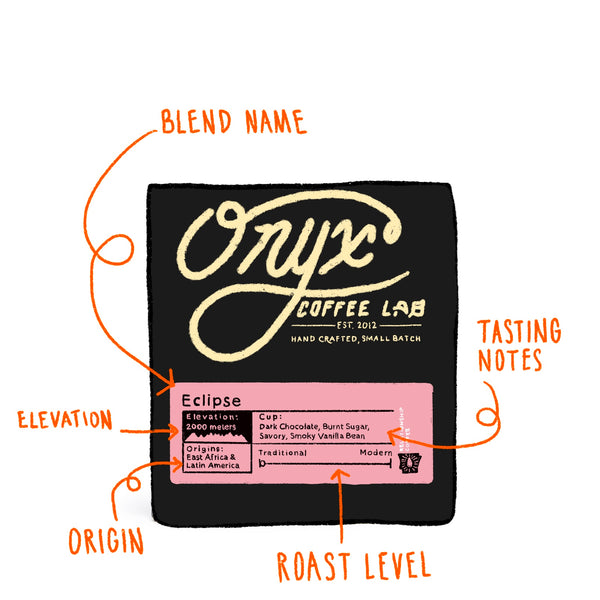
When you are trying to decide which bag of coffee beans to purchase, there can be a lot of information to take in. In this article, we will discuss the various terms and pieces of information you may see on a label and how each of those terms can influence the flavor of the coffee. Since there is an abundance of great coffee available these days, knowing what the different terms on a bag mean can help when trying to decide which one is right for you!
Origin
Origin refers to the country and sometimes the region within that country in which the coffee was grown. Countries of origin can be the main feature for many of us when buying a bag of coffee. Colombia, Kenya, El Salvador, Burundi—how do you know which one to choose? The easiest answer is to try different coffees until you find one you really like. Even though there are many different factors that influence a coffee's flavor, the country or region of the country it is grown is one of the biggest factors. Coffee beans can be single origin or blend. The minerals in the soil, the flora and fauna, and other crops grown in close proximity are just a few of the things that can have an influence on how a coffee plant grows at origin and the flavors it produces. 
Farm/Producer/Collective
The name of the person or group of people can be listed many ways but can be a great way to know if a certain coffee is one you may have tasted before. Names like Finca La Gloria, Kanzu, Catracha or Shakisso might be on the bag. Sometimes the name is the farm or farmer or sometimes it is the name of a station where farmers take their coffee to be processed after harvest. The best way to learn about these various producers is a quick search online. That will give you an idea of what types of coffee they typically produce and who may be roasting their beans.
Varietal/Type/Cultivar
Coffee ultimately is produce, and the fruit of the coffee can be one of many different types—sometimes even a hybrid of a few different types. Cultivars are coffee varieties that have taken on certain characteristics resulting from the environment in which they are grown. In the same way that there are different types of apples such as Pink Lady, Granny Smith, Fuji, Red Delicious, Shizuka and so on, there are different types or varieties of coffee. You may be familiar with names like Typica or Bourbon, but there are hundreds of different types of coffee fruit. Some are naturally occurring mutations of common varieties. For example, Maragogype is a very large fruit that is a mutation of the Typica variety named after the town in Brazil where it was discovered. Pacas is another mutation; this time it was Bourbon that mutated in Honduras and is named after the Pacas family for their discovery.

Processing
Processing is the way we describe the method that was used to dry the coffee once it is harvested. Washed coffee means that all of the fruit has been removed before drying. Washed coffees are the best way to notice the region in which the coffee was grown since it is solely the genetics of the seed giving it flavor. Honey process is a method where the coffee is depulped—a process where the seed is removed from the fruit of the coffee berry. It is then left to dry with some or all of the mucilage on the seeds. No honey is used, but the fruit gets sticky and gooey like honey as it dries. Honey coffees tend to be sweet and syrupy as a result. Natural process is a method of drying the coffee with the fruit fully intact on the seeds resulting in a very fruity cup. There are other processes as well like wet-hulled, anaerobic, tree-dried, and carbonic maceration. They all affect the resulting flavors in the coffee differently. The surest way to know which coffee process is your favorite is to try a few different types. Interested in learning more? Check out our blog post on coffee processing methods.
Roast Level
Roast level can be described as light, medium, or dark. There are other terms that are not used very often in specialty coffee, but you may see things like full city or French roast. These terms can be a bit more ambiguous, and as a result, most specialty roasters have opted to use more general terms. Think of roasting coffee as cooking the seed of a fruit. The longer coffee is roasted, the darker it will be and the less of the various components—acids, sugars, caffeine and all the various chemical compounds—that give coffee its flavor will dissipate. That doesn't necessarily mean that there will be less flavor, but it does mean that the flavors available will be easier to extract. For a brewing method like espresso, we want to get all of the flavor we can out of the coffee in a relatively short amount of time, so a darker roast can be a good thing. For a brewing method like pour-over, any roast level will work. A general rule to keep in mind is that the darker the roast, the lower the water temperature.
Roast Date
Roast date refers to the date that the coffee was roasted and bagged. Roasting creates a considerable amount of CO2 and other gasses within the beans. Most of this gas is released in the first 24 hours, but over the first week almost all of this will have escaped from the beans. The more time that has passed since it was roasted, the easier it will be to brew...to a point. For manual brewing methods like pour-overs or French press, wait at least three days from the day the coffee was roasted (five to seven days seems to be the sweet spot). For espresso, you’ll want to wait a little longer (at the earliest five days off roast) and the sweet spot tends to be seven to ten days after the coffee was roasted. The reason we recommend waiting longer to brew espresso is because of those gasses mentioned above. Since pressure is a key component in brewing espresso, it can be difficult to brew espresso with lots of CO2 still trapped in the beans. Ultimately, the number of days before a coffee achieves its “sweet spot” differs for various reasons and is subject to opinion.
Elevation
Elevation is the height above sea level that the coffee was grown. This is typically measured in meters and often displayed as MASL (meters above sea level). The higher the altitude at which the coffee is grown means the plant, and thus the fruit, will grow slower and the sugars in the coffee will have more time to fully develop. Generally speaking, the higher the elevation at which a coffee is grown, the more complex it will be in flavor. Typically lower elevation coffees will have lower acidity and flavors that tend to be more in the chocolatey and nutty range. Higher elevation coffees tend to offer more floral and fruit flavors.

Tasting Notes
Tasting notes can be one of the most difficult things to understand on a coffee bag. These are not flavors that are “added” to the coffee. You might taste a coffee and not notice any of the tasting notes you read on the bag, and that certainly doesn't mean that you brewed it wrong. The way that each person describes flavor is different. When one person says they taste “chocolate” in their coffee, they may be thinking of a dark chocolate—sweet, bitter and a full-bodied mouthfeel that has a coating-like quality to it. You may consider chocolate to be more of a milk chocolate or maybe a cocoa. We can all use the same descriptor but use it to express different things. Some tasting notes on a bag may be referencing the SCA (Specialty Coffee Association) flavor wheel, while some may be regional, cultural or “feel good” descriptors. Each coffee roaster is using tasting notes on their bag to communicate different things. Sometimes it is solely to let you know what types of flavors to expect and sometimes it is to compliment their branding.





























